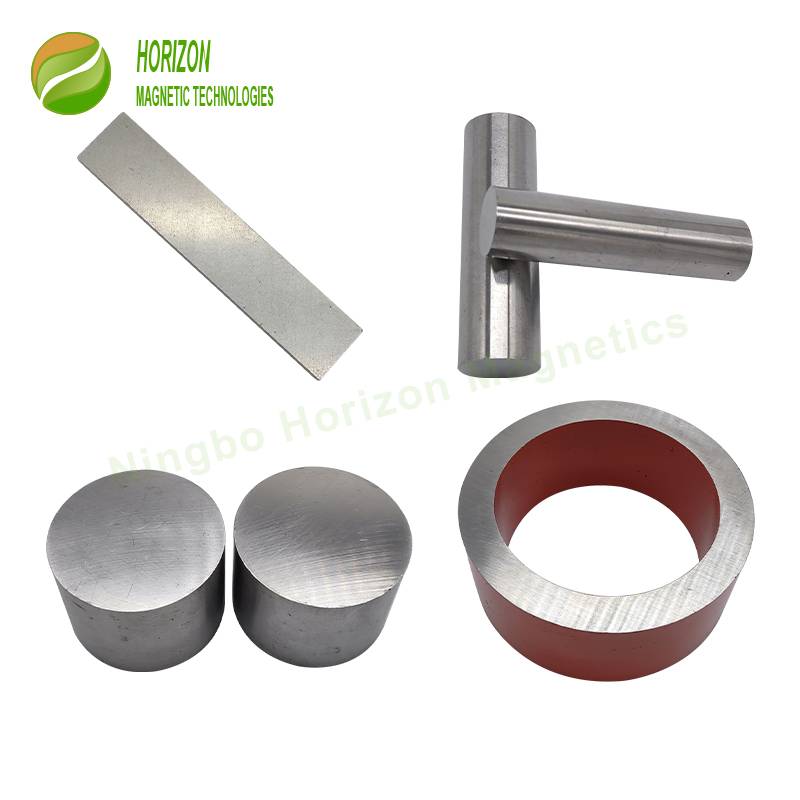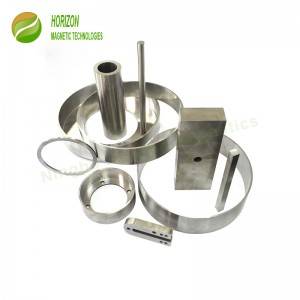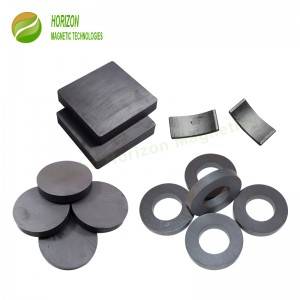Nowadays, in many applications Alnico has been replaced by Neodymium or Samarium Cobalt magnet. However, its property like temperature stability and very working high temperatures makes Alnico magnets indispensable in certain application markets.
1. High magnetic field. Residual induction is high to 11000 Gauss almost similar to Sm2Co17 magnet, and then it can produce high magnetic field around.
2. High working temperature. Its maximum working temperature can be high to 550⁰C.
3. High temperature stability: Alnico magnets have the best temperature coefficients of any magnet material. Alnico magnets should be regarded as the best choice in extremely high temperature applications.
4. Excellent corrosion resistance. Alnico magnets are not prone to corrosion and can normally be used without any surface protection
1. Easy to demagnetize: Its maximum low coercive force Hcb is lower than 2 kOe and then it is easy to demagnetize in some low demagnetizing field, even not handled with care.
2. Hard and brittle. It is prone to chipping and cracking.
1. As the coercivity of Alnico magnets is low, the ratio of length to diameter should be 5:1 or larger so as to get a good work point of Alnico.
2. As Alnico magnets are easily demagnetized by careless handling, it is recommended to make the magnetizing after assembly.
3. Alnico magnets offer outstanding temperature stability. The output from Alnico magnets varies the least with changes in temperature, making it an ideal choice for temperature sensitive applications, such as medical and military.
Definitely we are not an Alnico magnet manufacturer, but we are an expert in magnetic types of permanent magnets including Alnico. Moreover, our own produced rare earth magnets and magnetic assemblies will enable customers to have a one-stop purchase of magnet products from us conveniently.
| Cast / Sintered | Grade | Equivalent MMPA | Br | Hcb | (BH)max | Density | α(Br) | TC | TW |
| mT | KA/m | KJ/m3 | g/cm3 | %/ºC | ºC | ºC | |||
| Cast | LNG37 | Alnico5 | 1200 | 48 | 37 | 7.3 | -0.02 | 850 | 550 |
| LNG40 | 1230 | 48 | 40 | 7.3 | -0.02 | 850 | 550 | ||
| LNG44 | 1250 | 52 | 44 | 7.3 | -0.02 | 850 | 550 | ||
| LNG52 | Alnico5DG | 1300 | 56 | 52 | 7.3 | -0.02 | 850 | 550 | |
| LNG60 | Alnico5-7 | 1330 | 60 | 60 | 7.3 | -0.02 | 850 | 550 | |
| LNGT28 | Alnico6 | 1000 | 56 | 28 | 7.3 | -0.02 | 850 | 550 | |
| LNGT36J | Alnico8HC | 700 | 140 | 36 | 7.3 | -0.02 | 850 | 550 | |
| LNGT18 | Alnico8 | 580 | 80 | 18 | 7.3 | -0.02 | 850 | 550 | |
| LNGT38 | 800 | 110 | 38 | 7.3 | -0.02 | 850 | 550 | ||
| LNGT44 | 850 | 115 | 44 | 7.3 | -0.02 | 850 | 550 | ||
| LNGT60 | Alnico9 | 900 | 110 | 60 | 7.3 | -0.02 | 850 | 550 | |
| LNGT72 | 1050 | 112 | 72 | 7.3 | -0.02 | 850 | 550 | ||
| Sintered | SLNGT18 | Alnico7 | 600 | 90 | 18 | 7.0 | -0.02 | 850 | 450 |
| SLNG34 | Alnico5 | 1200 | 48 | 34 | 7.0 | -0.02 | 850 | 450 | |
| SLNGT28 | Alnico6 | 1050 | 56 | 28 | 7.0 | -0.02 | 850 | 450 | |
| SLNGT38 | Alnico8 | 800 | 110 | 38 | 7.0 | -0.02 | 850 | 450 | |
| SLNGT42 | 850 | 120 | 42 | 7.0 | -0.02 | 850 | 450 | ||
| SLNGT33J | Alnico8HC | 700 | 140 | 33 | 7.0 | -0.02 | 850 | 450 |
| Characteristics | Reversible Temperature Coefficient, α(Br) | Reversible Temperature Coefficient, β(Hcj) | Curie Temperature | Max Operating Temperature | Density | Hardness, Vickers | Electrical Resistivity | Coefficient of Thermal Expansion | Tensile Strength | Compression Strength |
| Unit | %/ºC | %/ºC | ºC | ºC | g/cm3 | Hv | μΩ • m | 10-6/ºC | Mpa | Mpa |
| Value | -0.02 | -0.03~+0.03 | 750-850 | 450 or 550 | 6.8-7.3 | 520-700 | 0.45~0.55 | 11~12 | 80~300 | 300~400 |


